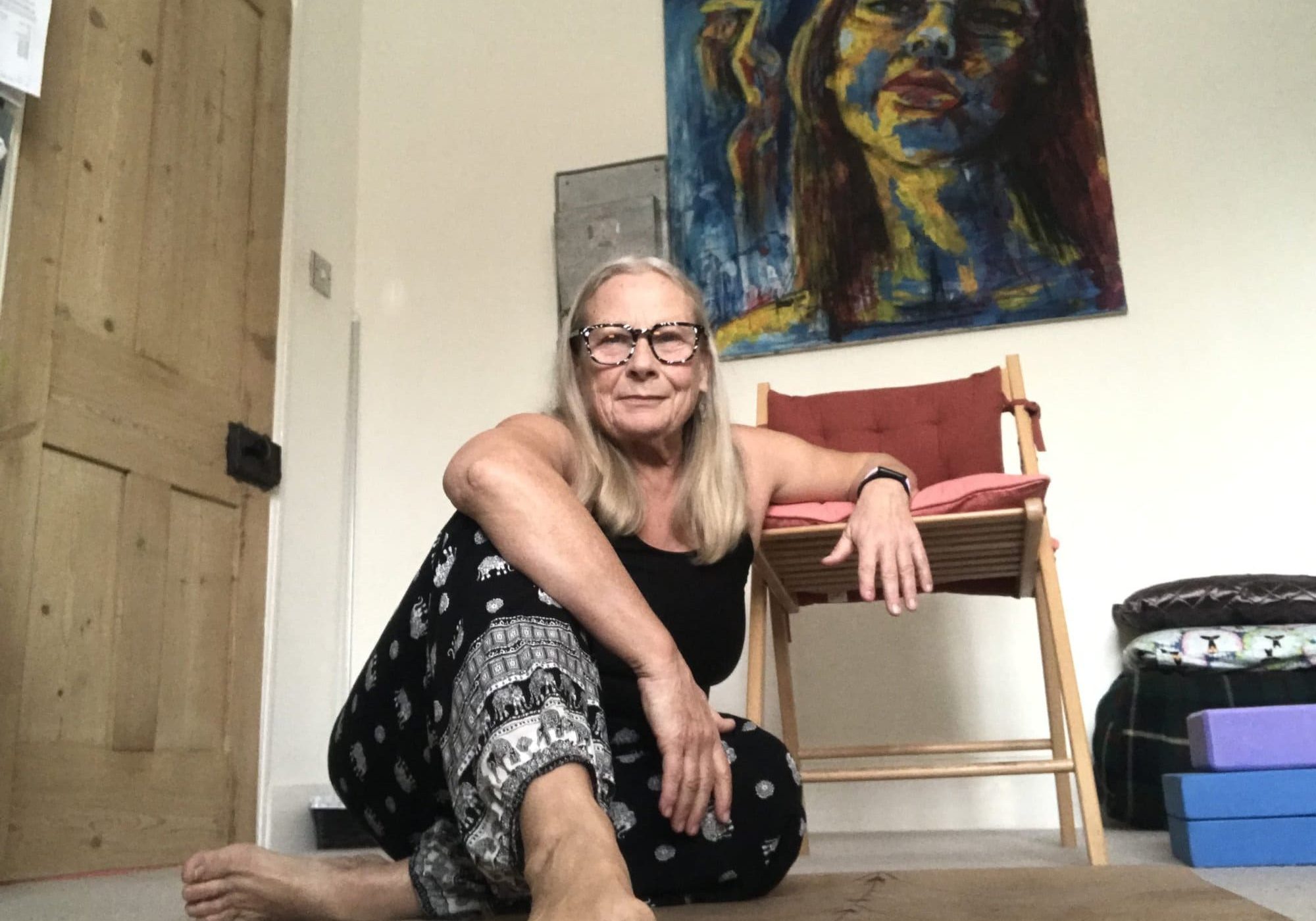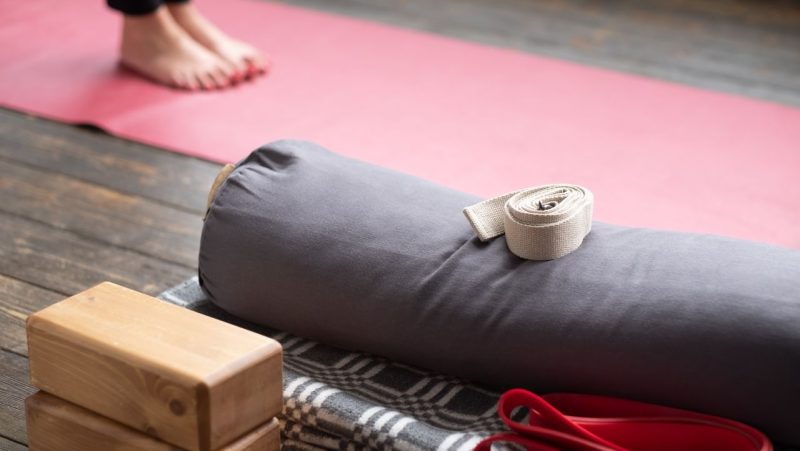
Chair Yoga for People with Terminal Illness
Teaching chair yoga to people affected by life-limiting conditions is a learning experience for the teacher as well as the participants, says Anne Caborn.
Reading time: 4 minutes
It still amazes me that state-of-the art yoga studios groaning with zafus, bolsters, blankets, bricks, and blocks very rarely have a set of chairs amongst their props. You can drag one in from the hall, but you get my point.
A chair creates an important connection between the body and the spirit in yoga. It makes a range of poses achievable and can also allow a yoga practitioner to reach new levels of attainment.
Renowned yoga instructor, Vanda Scaravelli, said we should not kill the instinct of the body for the glory of the pose. But if you have ever seen somebody transition seamlessly and powerfully through a Warrior sequence, with the aid of an Ikea folding dining chair, you realise that glory is no bad thing.
Not only can a chair improve the practice of yoga, it can also make yoga available to people who might otherwise be denied its benefits. Disadvantages caused by weak muscles, impaired energy levels, and mental fatigue can be levelled with the aid of a chair. Any chair.
A straight-backed dining chair can offer something to hold on to for balancing poses and is a good way to keep the spine erect, while an easy chair can offer comfort and security for someone uncertain of their capabilities, or unfamiliar with yoga. It is not so much stick with what you know as sit on what you know.
My work with Martlets Hospice
In 2018, I was approached by Martlets, a hospice in East Sussex providing essential services to local people affected by terminal illness. Martlets serves Brighton and Hove, and surrounding areas. The team there asked if I would be interested in running weekly chair yoga sessions as part of the outpatients’ programme.
I have taught chair yoga in several settings, from weight-loss groups to workplace wellbeing programmes, but it is my work with Martlets that has taught me the most.
Most people receive care from Martlets in their own homes. Others may spend their final days on the inpatient unit or stay for a week or two for respite care or symptom management.
Outpatients also visit the Hospice for pain relief, physiotherapy and counselling, and social activities from coffee mornings and creative writing programmes to guided meditation and chair yoga. Some of these services were adapted during the COVID pandemic and continue to be offered via telephone and online video sessions.
Terminal illness might be a journey of months, or years, and the traditional hospice model has been replaced by one which is less about an ending of days and more about ensuring a quality of life.
Ann Borg, Martlets’ wellbeing services manager, explains the importance of wellbeing activities and chair yoga for patients: ‘’We started our outpatient wellbeing service to help patients and their family members relax, reduce stress, and take some time to switch off from everything else.”
Martlets offer services including art, writing and social groups, as well as online sessions in chair yoga, tai chi, mindfulness and guided visualisations in nature.
“These sessions help people to connect with each other and feel part of a supportive community. They also give some people a structure where they are taking regular time to focus on their wellbeing,” Ann explains.
“Patients and carers have fed back that they enjoy the exercise that chair yoga gives them. The sessions feel gentle, but they still offer a good level of stretching and exercise for many who have limited mobility. Attendees often say that they are pleased with what they have been able to achieve in the session whilst still feeling able to go at their own pace and work within their own limits.’
‘’Chair yoga enables people to include exercise in their daily lives in a safe way. This can help them to feel that they are doing something positive for themselves, at a time when their mobility may be reduced and their focus is often about their medical treatment and medical journey. It can also be a great way of reducing stress and anxiety and bringing relaxation into their day to day lives.”
Ann says it is key for the yoga therapist to create routines that people of all abilities can do and to start by offering short sessions, say 20-30 minutes in length. Offering online sessions has made them more accessible to patients who are able to attend, even if they are feeling unwell, as they can join in from the comfort of their own home. “It also allows carers to attend sessions when they are unable to leave the person they are caring for. It has been a real success.’’
10 Tips for teaching chair yoga in a palliative setting
1. Feeling stable and secure
Settling people into their chairs at the start of the class is important and can be seen as part of savasana. I ask people to sit with their knees hip width apart and to ensure their feet are not tucked back under the chair. Bare feet are optional. Be aware that some people may be using a wheelchair with a footrest; (online teaching might make this less evident).
Sometimes I might encourage people to wiggle a little forward in a chair so their back is not resting and they can work a little harder supporting their own spines. But it is important that they adjust the position of their feet at the same time so they run no risk of overbalancing.
A chair can be a real asset when exploring standing poses, particularly balances, but standing is not available to everyone. I like to stick to poses that ensure maximum participation, so I avoid standing.
2. Illness and injury
In a traditional yoga class it would be usual to ask people about any illness or injury they might have. You give people a chance to mention something casually in open class, or to take you to one side if they would prefer not to widely share what they have to say.
When you are teaching in a care setting, issues around health have to be seen in the context of strict patient confidentiality. So I have replaced the standard illness and injury enquiry with a few words around listening to your own body and working to your own limits and accepting that those limits might vary significantly from day to day.
3. Think comfort not edge
Chair yoga for Martlets has encouraged me to rethink my approach to a number of core yoga principles, such as finding your edge. People with life-changing conditions may appear like any other yoga participant, but a bright smile and a sunny disposition can mask debilitating symptoms, even depression.
The last thing they need is someone at the front of the class exhorting them to push themselves or “dig a little deeper”. I find palliative chair yoga works best when taught well within any individual’s comfort zone, with the emphasis on self-awareness and exploration rather than exertion.
4. Fatigue
Fatigue can be a major issue for those with life-changing illnesses. But people may still want to participate even when their energy levels are extremely low. The social interaction element of a class is very important. The moments of chat at the start and the end of the session are as valuable as savasana.
It is good to have a lesson plan but be prepared to change what you have planned at the last minute, responding to both energy levels and what people chat about as they wait for the session to start.
5. Avoiding “How are you?”
I have been counselled by professionals to keep chat about health to a minimum. Even a casual reference to having “a bit of a cold” might be alarming to someone with a compromised immune system, even online.
Those with long term, serious conditions may prefer not to talk about their own state of wellness or hear about the conditions of others. So avoid “How are you?” as a conversation opener.
It is also important to look past any condition. When I first started teaching palliative chair yoga I asked Peter Blackaby, author of Intelligent Yoga - Listening to the body’s innate wisdom, for advice. He reminded me I was “treating a person, not a disease”.
6. Left and right
Another core yoga principle is working both sides of the body equally, but this is not always possible for someone with a medical condition. It is important that participants feel they can favour one arm or one leg, or work primarily or exclusively with the upper or lower body.
But I will encourage people to send mental messages to parts of the body that they are unable or reluctant to move. There is research that indicates that sending these mental messages can be beneficial, but it also allows participants to feel engaged and self-aware even when they are not moving.
7. Being with the breath
Even breathing techniques and instructions about them need to be thought through afresh when some of your clients might be challenged by chronic obstructive pulmonary disease (COPD), or varying levels of fatigue and breathlessness. Instead, I talk about breathing in a way that feels comfortable and seeing any reference I might make to take an inhale or an exhale as an invitation, not an instruction.
8. Ladder sequencing
Sometimes it is only when the class begins to move that you can really sense what that class is capable of on that day. Building a sequence in stages accomplishes two things. Firstly, it allows you to adjust the complexity and energy demands of the sequence up or down. You can stop adding in additional moves, or simplify additional moves, as you sense the class begin to tire.
Secondly, a ladder sequence stimulates the brain as well as the body, encouraging participants to remember what comes next and the order in which moves are performed. I might use a little Sanskrit, but by and large I give simpler, descriptive names for poses as it is easier for people to follow.
9. The spiritual
As well as talking people through the poses I will also blend in a little information about them. I might mention something that explores a spiritual or emotional context. I often refer to the story behind Warrior – Veerabhadra Asana.
Veerabhadra was a mighty warrior created by Shiva and the imagery can be useful in conjuring up a sense of empowerment. Seated Sun Salutations can be used to evoke the wider outside world and are a ritual that can be a comforting aspect of yoga.
10. The scientific
I might talk about Time Under Tension (TUT) and how holding a shape with the arms or legs can help stimulate the muscles. Or it might be something about how holding the arms above the level of the heart, even if it is just a little bit higher, can stimulate the circulation and lymphatic flow.
A little bit of science can also be empowering. Most of the people I teach know a lot about their medical conditions and enjoy absorbing facts and insights that help them understand how yoga is benefiting them mentally and physically.







